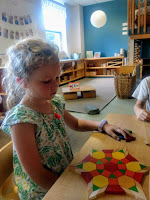Our morning message provided another invitation. This time, using what we know about our new tools (pencils and sticky notes) and what we've learned about the zones of regulation, I asked children to write their name on a sticky note and put their name in the zone they were in at that moment.
This was an incredible morning. Children were bravely honest and able to explain why they were feeling a certain way. We counted how many friends were in each zone and used rich math language to compare how many; Which zone are the most friends in right now? Which zone are the least friends in? These conversations help children- and adults- to normalize feelings.
As we moved through our morning something powerful happened. In the midst of a transition, Sebby quietly moved his sticky note from the blue zone to the green zone. Solveig did the same. We stopped. You may start your day feeling in the blue zone and that is okay, but being with your new peers and working together helps you to feel in the green zone.

Continuing our work with shapes by learning about different kinds of lines...
We can notice the different kinds of lines that shapes are made of. In Kindergarten we spend a lot of time exploring lines. We use lines to print letters, we use lines to print numbers, we use lines to draw shapes, we find lines in nature, we build lines every day with our bodies when we walk to lunch!
There are many different kinds of lines;
Straight, slanted, curvy, twisty, zig zag, messy, soft, or hard!
Later, we read a nonfiction book about Henri Matisse, an artist known for his use of shapes and lines. I introduced three new tools to now live in our classroom; art paper, scissors, and glue sticks.
The children used these materials to draw various lines with their scissors. We continued our conversations about the lines they cut and the many different kinds of shapes they used to create on their canvases. We have explored and learned about lines and shapes using math tools, our bodies, and art tools.







































































